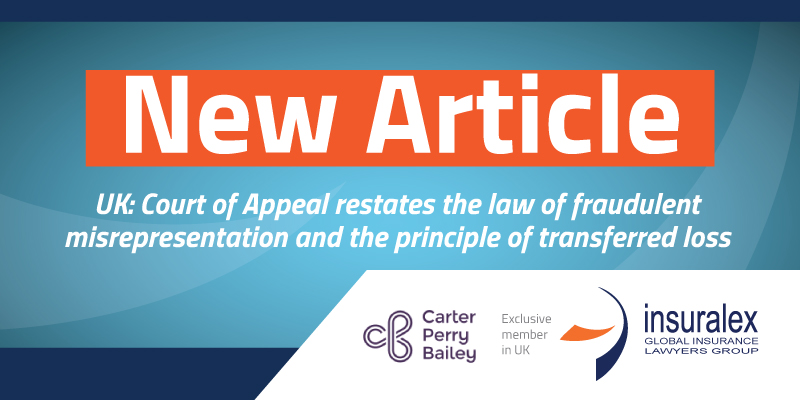
Nederlandse Industrie Van Eiprodukten v RembrandtEnterprises Inc [2019] EXCA Civ 596
Court of Appeal restates the law of fraudulent misrepresentation and the principle of transferred loss
This appeal raised two important issues in relation to fraudulent misrepresentation and the scope of the principle of ‘transferred loss’.
Background
The case arose out of the avian flu epidemic which hit the USA in April 2015. Millions of hens had to be slaughtered, which had disastrous effects for suppliers of eggs and egg products. One such company, Rembrandt had to source dry whole egg, dry yolk and dry white from the Dutch supplier, Nederlandse Industrie Van Eiprodukten (“NIVE”). The contract between the parties provided for the supply of 4200 metric tonnes of those products over a period of two years.
However, before it was confirmed that the import procedures satisfied US regulations, NIVE wrote to Rembrandt saying that, due to unforeseen additional regulatory costs, they would need to increase the purchase price. Rembrandt agreed to a price increase of €2.50 per kilogram. NIVE later informed Rembrandt that certain of the products would be supplied by its sister company, Henningsen van den Burg (“Henningsen”).
Rembrandt later sought to suspend the contract on the basis of NIVE’s alleged failure to comply with regulatory requirements. NIVE brought proceedings against Rembrandt for loss of profit arising out of the suspension. However, it became clear that NIVE’s earlier representation regarding the necessary increase in pricing had been made fraudulently in that it included an increased profit margin. Rembrandt defended the proceedings on the basis that (a) there had been a breach of warranty in that the products did not comply with US regulations, and (b) NIVE had fraudulently misrepresented the position which had induced Rembrandt to enter into the pricier contract.
First Instance decision
At first instance, Teare J found for Rembrandt and dismissed NIVE’s submission that, given the desperate circumstances, Rembrandt would have paid the additional cost even if it had known that the increased price included an element of profit and was not a genuine reflection of regulatory costs.
Teare J held there was a presumption that Rembrandt had relied on the (fraudulent) representations, and that it was entitled to rescind the contract containing the additional charges. In any event, NIVE could only have claimed for the loss it had directly suffered and not for that suffered by Henningsen. NIVE appealed.
Two important issues arose on appeal:
1.Fraudulent Misrepresentation
The Court of Appeal determined that in cases of innocent or negligent misrepresentation the law is clear – the burden rests with the representee to show it would not have entered into the bargain but for the inducement. However, in cases of fraudulent misrepresentation, there is a presumption that the representee was induced by the fraud to enter into the contract.
Delivering the lead judgment Longmore LJ said that the authorities “had assimilated the requirement of inducement in the tort of deceit and in actions for rescission for fraudulent misrepresentation and could be stated as being that the representee had to prove he had been materially ‘influenced’ by the misrepresentations in the sense that it was ‘actively present to his mind’…”.
A statement likely to induce a representee “is merely a presumption of fact which is to be taken into account along with the evidence. There was no requirement as a matter of law, that the representee should state in terms that he would not have made the contract but for the misrepresentation but the absence of such a statement was part of the overall evidential picture from which the judge had to ascertain whether there was inducement or not. The fact that there were other reasons (besides the representation) for the claimant to have made the contract did not mean that he was not induced by the representation made”.
Longmore LJ concluded that whilst the legal burden of proving the inducement rests with the representee, there is a presumption that the representee was induced, and it “is very difficult to rebut the presumption”. Whilst it is necessary to establish more than that representee ‘might’ have acted differently but for the fraudulent representation, that burden will be discharged if the representee establishes that it has been materially influenced. Furthermore, Longmore LJ explained that having a matter ‘actively present in the mind of the representee’ would, of itself, be adequate to demonstrate that a representee had been influenced to its detriment.
2. Loss suffered by the subcontractor, Henningsen
Since Henningsen was a sub-contractor, it could not pursue Rembrandt directly for its losses. Rembrandt’s contract was with NIVE only. Nevertheless, NIVE sought to recover Henningsen’s loss based on the little used theory of “transferred loss”, which arose from the Supreme Court decision in Swynson v Lowick Rose LLP [2017] UKSC 32; [2018] AC 313: “the principle of transferred loss is a limited exception to the general rule that a claimant can recover only loss which he has himself suffered. It applies where the known object of a transaction is to benefit a third party… and the anticipated effect of a breach of duty will be to cause loss to that third party.” (per Lord Sumption).
However, the Court of Appeal found this did not apply to the circumstances in Rembrandt, Coulson LJ having “no hesitation in concluding that, as a matter of law, for a successful claim for transferred loss … the claimant must show that, at the time the underlying contract was made, there was a common intention and/or known object to benefit the third party or a class of persons to which the third party belonged” (our emphasis).
Rembrandt had not been aware of the existence of Henningsen, let alone the possibility that Henningsen might supply some of the product on NIVE’s behalf, at the time it entered into the contract with NIVE. Accordingly, the claim for transferred loss failed.
CPB Comment
This decision makes it clear that where it is established that a representation was made fraudulently, it will be presumed that the person to whom it was made was induced by it. It is possible to rebut a
presumption, but in the case of a fraudulent representation, it will be very difficult to do so. It appears that Court will be understandably reluctant to find that a contract entered into following fraudulent representations can nevertheless be enforced, without compelling evidence that the fraudulent
representations actually played no part in the other party’s decision. Simply pointing to other factors in play will not suffice.
As to “transferred loss”, the judgment underlines that the principle is to be used as the exception to the general rule that a claimant can recover only loss which it has itself have suffered. It is therefore likely to remain a little used remedy.

Charlotte Menefy
Assistant Solicitor
T: 0203 697 1905
M: 07747 030879
E: charlotte.menefy@cpblaw.com
“This information has been prepared by Carter Perry Bailey LLP as a general guide only and does not constitute advice on any specific matter. We recommend that you seek professional advice before taking action. No liability can be accepted by us for any action taken or not as a result of this information, Carter Perry Bailey LLP is a limited liability partnership registered in England and Wales, registered number OC344698 and is authorised and regulated by the Solicitors Regulation Authority. A list of members is available for inspection at the registered office 10 Lloyd’s Avenue, London, EC3N 3AJ.”





